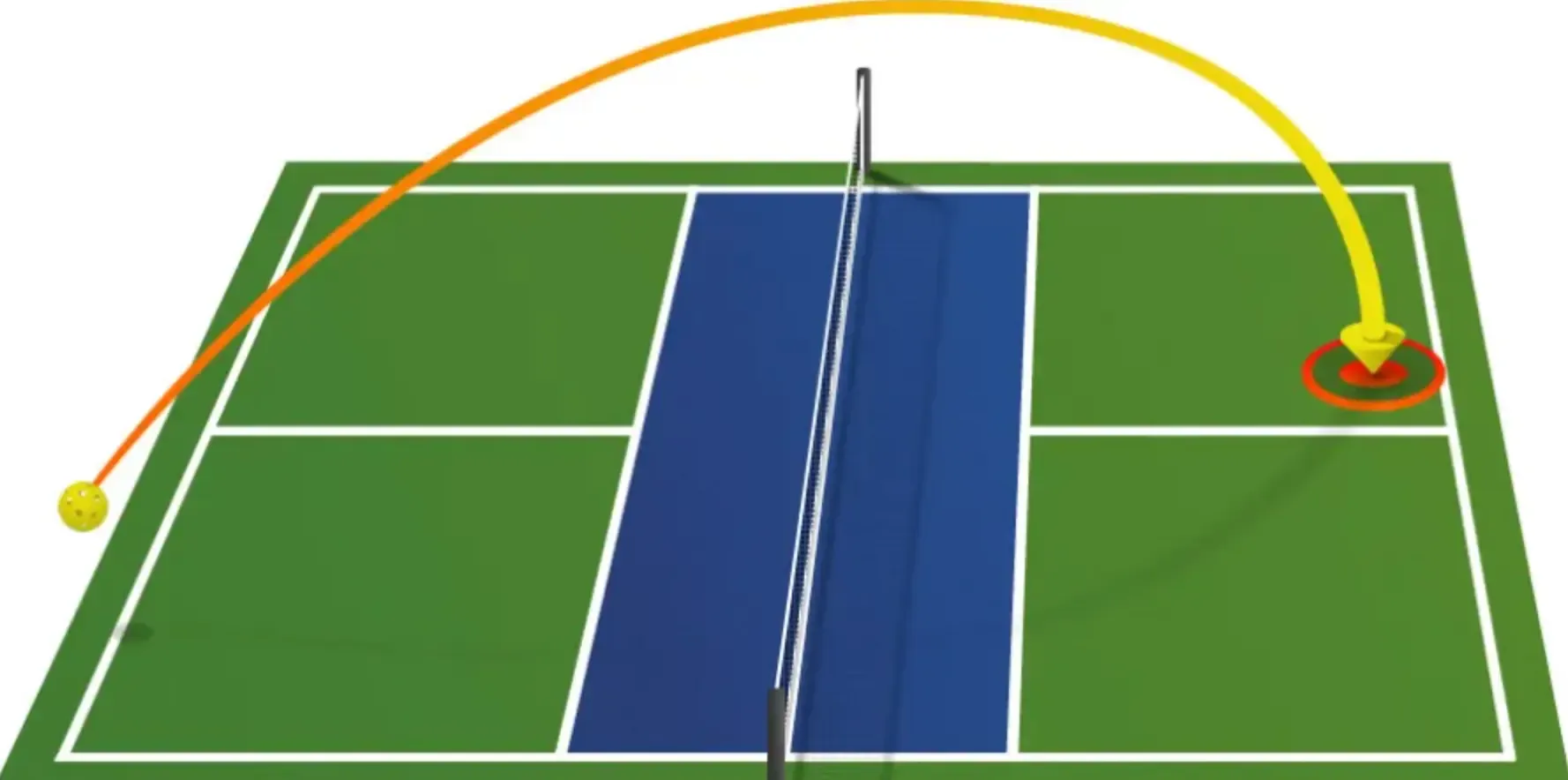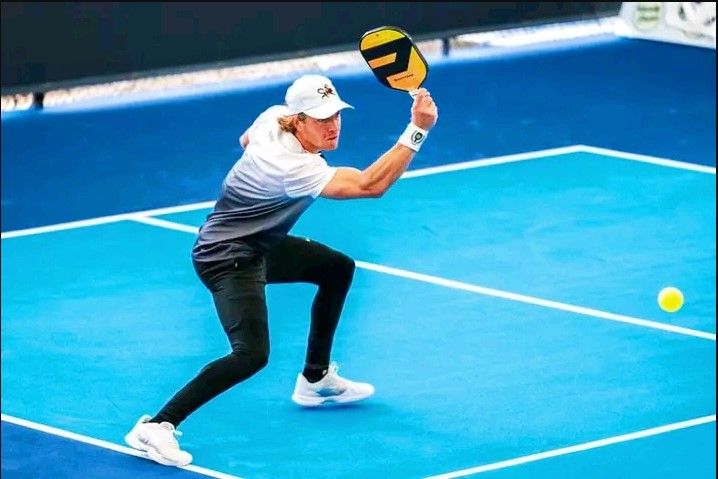Understanding the lob shot
The lob shot, known for its high trajectory and the ability to land deep in the opponent's court, is a crucial technique in any pickleball player’s repertoire. By pushing opponents back, the lob not only creates space but also gives the player a moment to regain control. While it may seem like a straightforward shot, there are several intricate elements that define its execution.
What is a pickleball lob shot?
A lob shot is characterized by its elevated arc, designed to sail over the heads of opponents, landing close to the baseline. The primary purpose of this shot is to push opponents away from the non-volley zone, commonly known as the kitchen, thus providing time for the player to reposition themselves. There are two main types of lobs: offensive lobs, which are often executed to catch opponents off-guard, and defensive lobs, which serve as strategic retreats when a player is under pressure.

In addition to offensive and defensive lobs, players can also choose variations such as regular lobs, which loft the ball high over opponents, and topspin lobs, where players aim to impart additional spin to ensure the ball drops sharply. This difference is pivotal as it influences both the trajectory and the bounce upon landing.
Why use a lob shot?
The tactical advantages of incorporating lob shots into gameplay are numerous. Firstly, lobbing often forces opponents back to their baseline, disrupting their offensive setup and making it more challenging for them to respond effectively. This shift can open up the court, allowing players to reposition and create favorable angles for their subsequent shots.
Furthermore, a well-executed lob can disrupt an opponent's rhythm, forcing them into an unexpected defensive stance. By altering the pace and style of play, players can induce mistakes from even the most skilled competitors. Practicing the lob shot not only enhances offensive strategies but also builds defensive resilience, allowing players to adapt to various game scenarios.
When is a lob shot not ideal?
While the lob can be a valuable tool, it’s vital to recognize scenarios where its use may be counterproductive. A notable downside occurs when an opponent is positioned deep in their court because a short lob can easily become a target for an overhead smash. Intermediate and advanced players particularly excel in returning these lobs, often converting them into aggressive counterattacks due to their ability to read the shot effectively.
Windy conditions can also exacerbate the risks associated with lob shots, making it challenging to control the ball's trajectory. In these situations, the player must weigh the likelihood of success against the potential for errors. Moreover, ethical considerations must be made when playing against less mobile opponents; taking advantage of a lob shot could inadvertently create an unlevel playing field.
Offensive lobbing strategies
When aiming to capitalize on the lob shot offensively, identifying the right opportunity is paramount. Knowing when to launch a lob can be the difference between enhancing your game and falling prey to counter-attacks.

Identifying the right opportunity
First and foremost, recognizing when an opponent is positioned near the non-volley zone line is crucial. In these moments, they are often leaning in, anticipating a quick follow-up shot, and are thus vulnerable to being caught off-guard by a surprise lob. Another prime opportunity is when the opponent is off-balance or moving sideways, as this can compromise their ability to respond quickly.
Players should cultivate their court awareness, assessing not only their positioning but also the dynamics of their opponents’ movements. The lob shot can serve as an effective counter to opponents who overcommit to the net, providing a strategic advantage in both singles and doubles play.
Executing the perfect offensive lob
To execute a successful offensive lob, players should begin with a low squat to harness power from their legs as they stand up. Utilizing a soft touch while holding the paddle in a hammer grip can disguise the intended angle. Players should maintain minimal backswing to avoid telegraphing their intentions while angling the paddle face slightly upwards for high trajectory.
Follow-through is equally important; it should direct the paddle upwards, emphasizing depth and control over raw power. Remember, maintaining consistent body language one that suggests preparing for a dink rather than a lob can further enhance the element of surprise, significantly increasing the chances of success in the shot execution.
Placement and trajectory
Strategic placement is fundamental for any lob shot. Players should aim for the opponent's backhand side, where they are usually less comfortable returning shots. Incorporating crosscourt lobs adds an extra dimension of complexity, as it creates more space and challenges the opponents' reach.
Ultimately, landing the ball deep into the opponent's court is crucial to maximizing the effectiveness of the lob shot. The goal should always be to make it difficult for opponents to anticipate and intercept, turning the shot into a tactical weapon rather than simply a desperate flick.
Defensive lobbing strategies
Just as offensive lobbing strategies can turn the tide of a match, defensive techniques can help recover momentum when under pressure.

When to use a defensive lob
Defensive lobs become necessary during situations where players find themselves out of position or unable to execute a clean offensive shot. In these circumstances, lobbing can buy valuable time to recover and reposition behind the non-volley zone line. It is particularly useful when an opponent has advanced near the net, catching them off-guard while providing the player a chance to regain composure.
Additionally, a well-timed defensive lob can disrupt an opponent's momentum, forcing them to reset their positioning and approach.
Technique and execution
Executing a defensive lob requires different mechanics compared to its offensive counterpart. The paddle face should be angled higher towards the sky upon contact, ensuring a higher arc that can extend the time the ball stays airborne. Following through vertically reinforces the upward trajectory, putting additional time and distance between the player and the incoming shot.
The emphasis should be on lifting the ball gracefully, avoiding mistakes such as excessive force that can cause it to fall short and leave players vulnerable to overhead smashes.
Positioning and recovery
Using the time bought by a defensive lob wisely is critical. Players must prioritize returning to a ready position, ideally retreating back towards the non-volley zone line. Staying alert and anticipating the opponent's counter shot can greatly influence the ability to respond effectively and maintain offensive control after the lob.
The lob serve
The lob serve, though less common, can serve as a surprise tactic to disrupt opponents' rhythm.
The advantages of a lob serve
Employing a lob serve can keep opponents behind the baseline, limiting their options right from the start. This strategy not only creates space for a third shot drop but also disrupts the opponent’s return rhythm, throwing them off balance.
Executing the lob serve
To effectively perform a lob serve, players should hold the paddle face up similar to gripping a frying pan while employing a slow to medium swing speed. Lifting the ball from a bent to fully standing position before making contact at net height maximizes the serve's effectiveness. Minimal backswing combined with an exaggerated follow-through ensures that the ball achieves the desired height and depth.
When to use a lob serve
Strategic considerations are key when deciding to employ a lob serve. It’s advisable to use this technique sparingly and mix it with driving serves. Targeting opponents who struggle with high bounces or deep returns increases the chance for an effective execution, pivoting the match in your favor.
Countering lobs: Turning defense into offense
Understanding how to counter lob shots can turn a potentially precarious situation into an advantageous position.
Reading the lob
Effective countering begins with anticipating the trajectory and depth of the lob. Carefully reading the angle at which the ball is approaching can give players the necessary edge to set up for their counterattacks effectively.
The overhead smash
The overhead smash is often the go-to response to a poorly executed lob. Technique plays a vital role in executing this powerful shot. Players should focus on positioning themselves under the ball, leveraging both a strong stance and timing to drive the ball back with intensity.
The drop shot counter
Alternatively, executing a drop shot against a lob can be an effective means of disarming opponents. This finesse shot requires careful placement, catching opponents off-guard. It’s crucial to identify the right moment for this counter, ensuring that the ball is strategically placed in the opponent's vulnerable areas.
Advanced lobbing techniques and strategies
For those looking to take their lobbing skills to the next level, understanding advanced techniques can make a substantial difference.
Adding topspin
Incorporating topspin into lob shots lends unpredictability to the ball's bounce, enhancing its effectiveness. By contracting the wrist and adjusting the paddle face during contact, players can generate the desired spin that challenges opponents' ability to return.
Mastering disguise
Fooling opponents with deceptive mechanics can significantly improve success rates. Consistency in body language and mechanics leads to a more unpredictable game, keeping competitors on their toes.
Utilizing wind conditions
Wind can dramatically affect shot trajectory. Understanding how to adjust your lobbing technique in windy conditions both headwind and tailwind can be pivotal in maintaining control during gameplay.
Common mistakes and how to avoid them
Despite the advantages of the lob shot, players often encounter hurdles during execution. Avoiding common pitfalls can significantly enhance success rates.
Telegraphing your lobs
One major mistake players make is telegraphing their intentions with exaggerated backswing or changes in body language. To maintain unpredictability, it’s crucial to keep body movements consistent from one shot to the next.
Incorrect grip and paddle angle
Using an improper grip or paddle angle can lead to ineffective lobs. Ensuring that the paddle face remains correctly angled and maintaining a controlled grip can facilitate proper shot height and trajectory.
Lobbing at the wrong time
Players often miss opportunities due to poor judgment in timing. Assessing opponent positioning and court dynamics can help avoid unnecessary lobbing situations, thereby improving overall shot selection.
Drills to sharpen your lobbing skills
Consistent practice is key to mastering lob shots. Incorporating specific drills can enhance both accuracy and consistency.
Partner drills for consistency
Working with a partner can provide valuable feedback while practicing lobbing techniques. Repetitions focused on target practice can aid in refining placement and trajectory.
Solo drills for technique
Engaging in solo drills, such as wall drills and shadow swinging, allows players to focus on self-correction. This dedicated practice can enhance mechanics without needing a partner.
Game situation drills
Simulating match situations will help prepare players for real-time pressure. Engaging in decision-making drills can build confidence and instinctively improve shot selections during gameplay.
The psychology of the lob: Mastering the mental game
Mastering the mental game can be just as crucial as achieving physical prowess. Understanding the psychological aspects of lobbing can play a significant role in gameplay.
Building confidence in your lob
Harnessing confidence in the lob shot often requires dedication and practice. Visualization techniques and positive self-talk can significantly enhance a player’s belief in their abilities.
Patience and shot selection
It’s essential to remain patient and wait for the right opportunity to execute a lob. Avoiding forced shots can lead to better decision-making and higher success rates when lobbing.
Disrupting your opponent's rhythm
A well-placed lob not only disrupts physical dynamics but can also impact the opponent's mental game. By forcing adversaries to adapt, players can create significant advantages during matches.
Conclusion
Mastering the pickleball lob shot is an essential skill that can redefine gameplay strategies, offering players tactical tools for both offense and defense. Understanding its mechanics, identifying ideal opportunities, and honing execution can transform the lob into a game-changing weapon on the court. By applying advanced techniques and maintaining an acute awareness of both physical and psychological elements, players can significantly enhance their overall performance. Through dedicated practice and strategic thinking, the lob shot will become a cornerstone of your pickleball arsenal, elevating your game to new heights.










